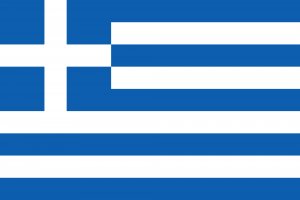Language/Modern-greek-1453/Vocabulary/Asking-for-Directions
| ◀️ Modes of Transportation — Previous Lesson | Next Lesson — Common Prepositions ▶️ |
As a beginner in the study of Modern Greek (1453-), knowing how to ask for directions is essential. In this lesson, you will learn how to ask for directions and understand responses in Modern Greek. We will cover important vocabulary related to asking for directions, including common places, directions, and prepositions. By the end of this lesson, you will be able to navigate through Greek cities and towns with more ease and confidence.
Take some time to dive into these other pages after completing this lesson: Countries (Xwres Χώρες) & Greek Roots in Medecine.
Vocabulary[edit | edit source]
To ask for directions in Modern Greek (1453-), you'll first need to know some important words and phrases. Here are some useful ones to get you started:
| Modern Greek (1453-) | Pronunciation | English Translation |
|---|---|---|
| Πού είναι; | Poo eeneh? | Where is it? |
| Τι ώρα είναι; | Tee ora eeneh? | What time is it? |
| Δεξιά | Deksia | Right |
| Αριστερά | Aristera | Left |
| Ευθεία | Eetheea | Straight ahead |
| Πίσω | Piso | Behind |
| Κοντά σε | Konta seh | Near to |
| Εδώ | Edo | Here |
| Εκεί | Eki | There |
| Πολύ μακριά | Polee makreea | Far away |
Grammar[edit | edit source]
When asking for directions, you'll need to use prepositions to describe where you want to go. In Modern Greek (1453-), the prepositions you'll need to know are:
| Modern Greek (1453-) | Pronunciation | English Translation |
|---|---|---|
| Σε | Se | To, in, on |
| Προς | Pros | Towards |
| Από | Apo | From |
| Για | Ya | For, towards |
| Μέσα στο | Mesa sto | Inside the |
| Έξω από | Exo apo | Outside the |
Here are some example sentences using these prepositions:
- Πού είναι ο κινηματογράφος...; (Poo eeneh o keenematrographos?) - Where is the cinema?
- Πού είναι το μουσείο...; (Poo eeneh to mousio?) - Where is the museum?
- Πώς μπορώ να πάω στην Ακρόπολη; (Pos peegeeno stin Akropolie?) - How do I get to the Acropolis?
- Πώς μπορώ να πάω δεξιά; (Prepei na pao pros ta deksia?) - Do I need to go towards the right?
- Πού μπορώ να βρω ένα σουβλατζίδικο; (Poo boroh na vro to souvlaki?) - Where can I find souvlaki?
- Το ξενοδοχείο είναι μέσα στην πόλη. (To xenodocheio eeneh mesa stin poli.) - The hotel is inside the city.
- Η στάση λεωφορείου δεν είναι στο κέντρο. (I stasi too leoforeiou eeneh exo apo to kentro.) - The bus stop is outside the center.
Remember that in Modern Greek (1453-), the definite article is important. In the examples above, "ο" (o) is the definite article used before "κινηματογράφος" (cinema), while "την" (tin) is used before "Ακρόπολη" (Acropolis).
Dialogue[edit | edit source]
To further practice asking for directions in Modern Greek (1453-), here's a sample dialogue with a local Greek asking for directions to a hotel:
- Γιάννης: Καλημέρα! Μήπως ξέρετε πού είναι το ξενοδοχείο ...; (Yanis: Kalimera! mîpos xèrete poù îne to xenodocheio....?)
- Άννα: Καλημέρα! Το ξενοδοχείο είναι ευθεία, στην πλατεία. Είναι αμέσως μετά το σούπερ μάρκετ και ευθύς αριστερά, στο πρώτο δρόμο. (Anna: Kalimera! To xenodocheio eeneh eki, eetheea eempros mehri tin plateea. Eeneh meta to supermarket ke aristera sto proto dromo.)
- Γιάννης: Ευχαριστώ πολύ! (Yanis: Efharisto poli!)
- Άννα: Παρακαλώ! Καλή διαμονή! (Anna: Parakalo! Kali diamoni!)
In this dialogue, Γιάννης (Yanis) asks Άννα (Anna) where the hotel is, and she gives him detailed directions using prepositions and prepositional phrases. At the end of the conversation, she wishes him a pleasant stay.
Practice[edit | edit source]
To practice asking for directions in Modern Greek (1453-), try the following exercise. Imagine you are in Athens and need to find the nearest pharmacy. Ask a local for directions using the vocabulary and grammar you've learned in this lesson.
When you're finished, try switching roles and have your Greek-speaking friend ask for directions to a tourist attraction in your city using Modern Greek (1453-).
Conclusion[edit | edit source]
Asking for directions in Modern Greek (1453-) can seem daunting at first, but with practice and some basic vocabulary and grammar knowledge, you can navigate your way around Greek cities and towns. Remember to use prepositions and prepositional phrases to describe where you want to go, and don't be afraid to ask for clarification if you don't understand a response. With time and practice, you'll be able to communicate with locals and explore Greece with ease.
Upon wrapping up this lesson, take a look at these related pages: Most common adjective in Greek & Fruits.
Other Lessons[edit | edit source]
- Seasons
- Health and wellness
- Colors and shapes
- Χώρες Γλώσσες Εθνικότητες
- Science and technology
- Shades of Colors
- Medicine
- The 100 most common expressions in Greek
- Politics and government
- How to say Good Bye?
| ◀️ Modes of Transportation — Previous Lesson | Next Lesson — Common Prepositions ▶️ |

